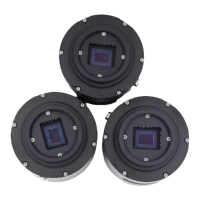QHY183C
22
7. What's on-camera DDR buffer and what is benefit for?
The QHY183C has the on-camera 128MB DDRII image buffer. It brings two advantages: It can
buffer whole image and avoid it lost during USB transfer. Because CMOS sensor outputs the
image continuous after exposure end and it does not allow the pause. But the computer may
have some pause due to the multi-task feature of the windows. If the pause is too long, the small
buffer in the USB transfer chip will full and the coming image data will lost. And it will cause one
frame is lost some data and this frame will be a bad frame. For short exposure it maybe not cause
big problem because the next frame will comes soon. But for long exposure it means you lost a
long exposure frame. The 128MB DDRII buffer can solve this problem by storing the whole frame
into it and transfer. Even the computer has big pause it will not lost data.
Another advantage is that it will make the video more smooth when in some slow computer or
some mainboard which is not friendly to USB3.0(like the VIA chipset) . In these computers they
cannot handle the high speed USB data well and the data is always lost. With this DDR it can
buffer the input image data and then send to computer. Even the high frequency pause happens,
it can keep the USB data lossless.
SharpCap version has options for enabling/disabling the DDR buffer. The current ASCOM driver is
always working under DDR enabled mode.
8. What's the QE of QHY183C?
Sony has not released the absolutely QE curve of the IMX183 sensor. Here is the relativity QE
curve. It is just the normalization QE. Normally speaking the BSI sensor has a very high QE. Please
refer this topic http://qhyccd.com/bbs/index.php?topic=5485.0

